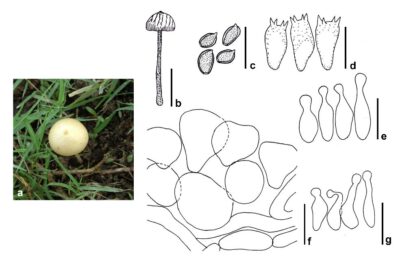Fungalpedia – Note 196, Conocybe
Conocybe Fayod
Citation if using this entry: Bera et al. 2024 (in prep) – Fungalpedia, Basidiomycota 1.
Index Fungorum, MycoBank, Facesoffungi, GenBank, Fig. 1
Classification: Bolbitiaceae, Agaricales, Agaricomycetes, Basidiomycota, Fungi
The name “Conocybe” is derived from the Greek words “cono,” meaning cone, and “cybe,” meaning head, referring to its characteristic conical shape of pileus. Belonging to the Bolbitiaceae, Conocybe can be distinguished from the other genera of this family by the presence of the non-plicate-sulcate pileus margin and lecythiform or capitate cheilocystidia (Amandeep et al. 2015). Members of this genus have small to medium-statured slender basidiomata which generally dwell on a wide range of substrates like on soil or dunes, decayed woods or dung, or even associated with plant remains (Singer 1986, Pegler 1977, 1983, 1986, Amandeep et al. 2015). However, the preferred habitat of Conocybe is fertile soils in pastures and lawns. The phylogenetic inference of Bolbitiaceae by Tóth et al. (2013) revealed the dispute in the generic level of Conocybe and another genus, Pholiotina Fayod. Many schools of thought have considered Pholiotina as a subgenus under Conocybe, but this treatment contradicts the lecythiform cystidia of Conocybe with fusiform- utriform cystidia of Pholiotina (Tóth et al. 2013). Consequently, many of the former taxa having partial veil and no lecythiform cystidia but were treated under Conocybe have been transferred to Pholiotina (Tóth et al. 2013).
Another similar genus is Galerina Earle, which can only be distinguished by the microscopical characteristics of its filamentous pileipellis, which differs from the cellular nature of pileipellis in Conocybe (Smith & Singer 1955). The type species, Conocybe tenera (Schaeff.) Fayod, is a saprotroph with typical conical to convex shaped, brownish pileus (Hausknecht 2000). The lamellae have an adnate attachment and usually darken on maturity (Hausknecht 2000). The stipe of this species is bulbous at the base with no annulus and has a hollow context (Hausknecht 2000). The basidiospores are smooth and ellipsoid with germ pores (Hausknecht 2000). Conocybe is also known for the presence of hallucinogenic compounds. Conocybe velutipes (Velen.) Hauskn. & Svrček, and C. siligineoides R. Heim are reported to contain psilocin and psilocybin (Guzmán et al. 1998, Gotvaldová et al. 2022). Another species, Conocybe filaris (Fr.) Kühner, is often compared with the death cap mushroom Amanita phalloides (Vaill. ex Fr.) Link because of the similar toxins present. Members of Conocybe, often called “dunce caps,” have been reported worldwide and have over 200 species documented (Kirk et al. 2008, Species Fungorum 2023).
Synonyms: Gastrocybe Watling, Pholiotella Speg., Pseudoconocybe Hongo, Raddetes P. Karst.
Type species: Conocybe tenera (Schaeff.) Fayod
Other accepted species: Species Fungorum – search Conocybe)
Figure 1 – Conocybe magnicapitata (PUN 4801). a & b Basidiomata. c Basidiospores. d Basidia. e Cheilocystidia. f Pileal elements. g Caulocystidia. Scale bars: a = 3 cm, c–g = 20 μm. Taken from Amandeep et al. (2015).
References
Pegler DN. 1983 – Agaric flora of the lesser Antitles. Kew Bulletin Additional Series 9, 668 pp.
Pegler DN. 1986 – Agaric flora of Sri Lanka. Kew Bulletin Additional Series 12, 514 pp.
Smith AH, Singer R. 1955 – New species of Galerina. Mycologia, 47(4), 557–596.
Entry by
Ishika Bera, Center of Excellence in Fungal Research, Mae Fah Luang University, Chiang Rai 57100, Thailand
(Edited by Kevin D Hyde, Samaneh Chaharmiri-Dokhaharani, & Achala R. Rathnayaka)
Published online 6 February 2024
